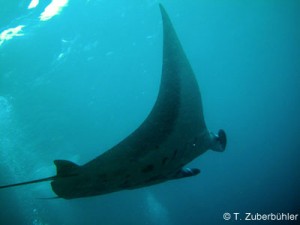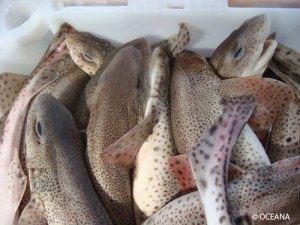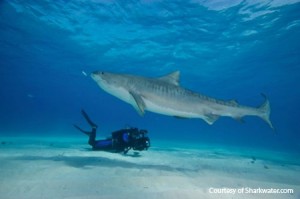Rays and sharks are extraordinary animals
Rays are fish and belong, along with sharks, to the class of the cartilaginous fish (Chondrichthyes). Their skeletons do not consist of bone material – as do humans’ – but of cartilage. Most ray species dwell in the ocean, but some can be found in rivers. They eat small animals and are innocuous to humans – one exception being the stingray, which possesses a poisonous thorn on its tail, for use as an efficient means of defence.
Rays and sharks grow very slowly, reach sexual maturity late and have few offspring after a long gestation period. As a result of this life cycle, they are very sensitive to overfishing. The number of sustainably fishable cartilaginous fish is, therefore, much smaller than that of bony fish. The latter often occur in large schools and can produce a lot of offspring in a short period. Nevertheless, even those species have been overexploited in recent years.
Today more and more rays are harvested for the purpose of leather production.
One of the most exploited rays for the leather production:
Cowtail Stingray (Pastinachus sephen)
Red List 2007: data deficient
Fish Base 2010: threat of extinction by overfishing
Disc dimension: almost 2 metres. The cowtail stingray occurs in the Indo-Pacific and throughout Southeast Asia. It dwells mostly in reef lagoons and reef shores but can also be found in rivers far off the sea. It feeds on small fish, worms, shrimp and crabs. It used to be sought after for food, and its skin for polishing wood.
Because of the three large grains on the centre of its back (which make the leather especially prized), the cowtail stingray has become the most heavily harvested ray species for leather production, particularly in Southeast Asia. Marine biologists fear that it will soon be extinct (www.fishbase.org).
.
The following species are also fished:
Devil Fish (Mobula mobular)
Red List 2006: endangered
Red List 2000: vulnerable
Disc dimension: more than 5 metres. This species is especially vulnerable due to its limited distribution (Mediterranean and Black Sea) and very low reproductivity rate. It often is an unintended victim of industrial fishing. Today the manta ray leather is advertised for sale on the internet.
.
.
.
Spotted Eagle Ray (Aetobatus narinari)
Red List 2006: near threatened
Red List 2000: data deficient
Disc dimension: more than 3 metres. This large ray species is particularly popular with divers. The Eagle ray lives in the warm waters of the Indo-Pacific and the East and West Atlantic. Due to overfishing, its numbers are in severe decline. Today the leather industry advertises eagle ray leather on the internet.
.
.
.
Blue-Spotted Stingray (Taeniura lymma)
Red List 2005: near threatened
Red List 2000: low risk/near threatened
Disc dimension: around 0.3 metres. The Blue-Spotted Stingray makes its home around the coral reefs of the Indo-West Pacific. Although the small specimens are popular among marine aquarists, they don’t do well in aquariums. Almost no information is available on age at maturity, longevity, average reproductive age or annual fecundity. No conservation or management initiatives are in place.
.
.
.
.
Two of the most heavily harvested sharks for the leather production:
.
Small-Spotted Catfish (Scyliorhinus canicula)
Red List 2010: not evaluated
This little shark grows to only about 60 cm in length. It lives in the North Sea, the Atlantic Ocean and the Mediterranean, where it dwells on gravelly ground as deep as 400 metres.
.
.
.
.
.
.
Nursehound (Scyliorhinus stellaris)
Red List 2010: not evaluated
The nursehound reaches a length of 1.7 metres and lives around 19 years. It can be found as deep as 100 metres in the North Eastern Atlantic and the Mediterranean.
.
.
.
.
.
The following species are also fished:.
Spiny Dogfish (Squalus acanthias)
Red List 2006: vulnerable
Red List 2000: low risk/near threatened
The spiny dogfish is a small shark (1.6 metres, 9 kg) that can live for up to 75 years, reaching maturity at between 10 and 30 years of age. After a gestation period of 22 months, it only has two pups. It is a cosmopolitan species that is highly migratory. Hardly any regional fisheries management is in place for the species.
.
.
.
Tiger Shark (Galeocerdo cuvier)
(Galeocerdo cuvier)
Red List 2005: near threatened
Red List 2000: lower risk/near threatened
The tiger shark belongs to the big shark species. It can grow to more than 7 metres and 750 kg and reach 50 years of age. It only reaches maturity at around 9 years and has a gestation period of one year. It lives along coasts but also in the open sea in all waters down to a depth of 350 metres, although it prefers estuaries and lagoons. There are no specific conservation or management measures in place for the tiger shark.
.
Great Hammerhead Shark (Sphyrna mokarran)
Red List 2007: endangered
Red List 2000: data deficient
The great hammerhead shark reaches a length of 6 meters and a weight of 400 kg, and its gestation period is longer than a human’s. It lives in tropical waters, the Red Sea and the Mediterranean, preferably in the open water but sometimes close to the coasts and between the surface and 100 metres of depth.
.
.
.
Greenland Shark (Somniosus microcephalus)
Red List 2006: near threatened
The Greenland shark is a large shark (over 7 metres and 770 kg) that reaches maturity late. It is one of the few sharks living in the polar waters of the North Atlantic and Pacific, where it can be found as deep as 2000 metres. It seems to grow very slowly and it can reach the ripe old age of 200 years.
